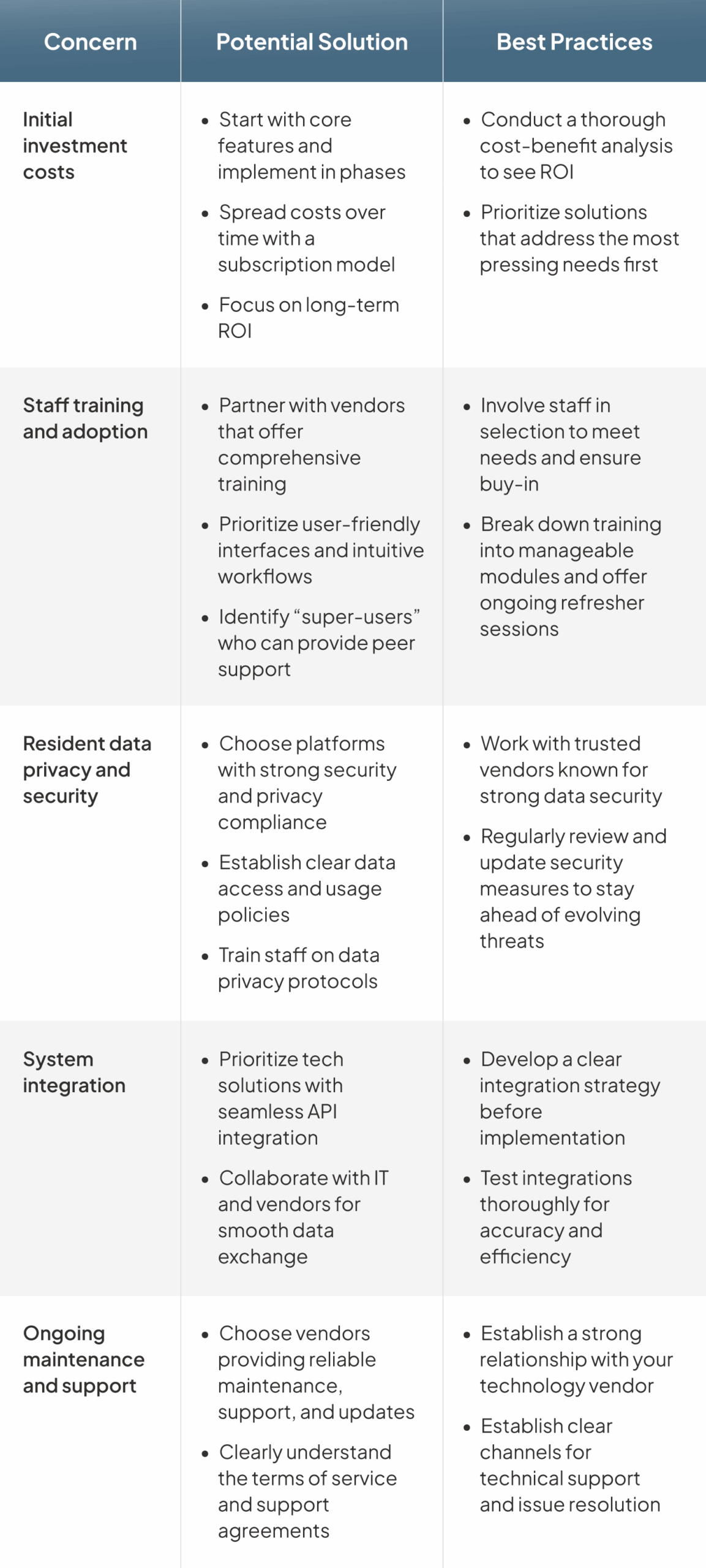How Resident Care Data and Technology Improve Your Resident Experience
Better care starts with better insights. Learn how senior living teams are using data and technology to create more meaningful resident experiences.

Better care starts with better insights. Learn how senior living teams are using data and technology to create more meaningful resident experiences.
Published on: June 25, 2025
Last updated: July 11, 2025

Contents
Providing exceptional resident experiences is the cornerstone of a thriving community, but that doesn’t mean offering costly, luxury offerings that will go out of style in a year or two. Instead, the answer lies in thoughtfully using technology to leverage resident care data for more personalized, responsive support.
Many people mistakenly view data and technology as impersonal or even at odds with human caregiving, but that perception no longer reflects how today’s senior living communities are using tech to enhance, not replace, personal care. When used correctly to capture, analyze, and act upon valuable insights, resident data helps communities better understand each resident’s unique needs and preferences to deliver more personalized and effective care.
This thoughtful use of data and technology doesn’t just elevate the resident experience — it creates a foundation for more connected, efficient, and responsive care.
Senior living communities generate a wealth of resident data, but too often, that information sits in disconnected systems where it can’t support better care. With a unified data system, resident information paints a full picture of each individual’s needs, preferences, and daily routines — easily accessible to care teams, residents, and families alike.
Resident portals empower residents with personalized details, such as daily schedules, upcoming activities, dining menus, and important community announcements. This level of transparency helps residents feel informed and in control, reducing anxiety and strengthening their connection to the community. Providers can also track interests, participation, and dining preferences to create more personalized experiences that foster long-term engagement.
Family members often feel guilt and uncertainty when placing a loved one in senior living. A 2023 Gallup survey found that nearly half of Americans believe senior living is unsafe, and over 60% feel anxious about transitioning a family member into care. Secure communication apps that offer real-time updates on care and activities help ease those concerns.
Providing reassuring and timely updates to family offers several benefits:
Let’s use a hypothetical scenario to examine what this might look like in practice.
Eleanor, 82, recently moved into a senior living community. Her daughter, Sarah, lives several states away and was calling multiple times a week for updates. Without an interconnected data system, Eleanor’s information was scattered across different platforms.
Sarah often spoke to staff who couldn’t answer her questions, and Eleanor missed out on activities she would have enjoyed. Her dining preferences also weren’t tracked, leading to frequent meal dissatisfaction.
After implementing a resident care platform with integrated portals, everything changed:
Together, connected data and easy-to-use technology strengthen relationships, reduce stress, and enhance the resident experience for everyone involved.
Some still believe technology leads to a “sterile” or impersonal approach to senior care. But in reality, the right solutions give caregivers deeper insight into each resident, empowering them to deliver more attentive, responsive care.
By collecting and analyzing data from multiple sources, technology helps care teams understand not just who a resident is today but how their needs may be evolving. Real-time visibility into preferences, behaviors, and health status enables more proactive support and fewer surprises.
AI-powered tools are especially valuable for identifying subtle trends, like changes in sleep, movement, or appetite, that may signal emerging health concerns. Instead of waiting for a pattern to become obvious, care teams can intervene early, improving outcomes and reducing emergency responses.
A major study from the Wexner Medical Center shows that 75% of Americans believe using AI in health care, including senior living communities, is important to minimize human errors. At the same time, concerns around data privacy remain, making it critical for providers to choose AI tools that are not only powerful but secure and transparent.
“Senior living providers need a tech platform to capture data and deploy predictive analytics to create customized solutions. It’s these customized solutions that will drive real value for investors, owners, operators, and customers.” – Robert Kramer, NIC co-founder and strategic advisor, when discussing the future of senior living.
Consider this scenario.
Eleanor is usually active, independent, and happiest when tending the community garden. But recently, she’s been less enthusiastic, occasionally skipping her afternoon walks and eating less at meals.
While her care team may have eventually noticed the change, the community’s AI-enabled resident care system picked up on it faster when her dining hall check-in patterns slightly decreased and she stopped checking in at the community garden on nice days.
The system flagged the pattern and sent an alert to her caregiver, Emily. At the end of her shift, Emily checked in. Eleanor mentioned her knee had been bothering her.
Thanks to that timely conversation, Emily coordinated a physical therapy assessment and arranged simple modifications to make gardening more comfortable again. That early intervention prevented a potential injury, preserved Eleanor’s independence, and protected her mental well-being.
Modern senior living software also improves communication across care teams. With centralized access to relevant information, staff can collaborate more effectively and make confident decisions based on a complete picture of each resident.
Technology isn’t replacing the human touch in senior care — it’s strengthening it.
When applied strategically, resident care data becomes a powerful tool for reducing risk and creating a safer environment. Instead of reacting after an incident occurs, communities can use data insights to intervene early.
Take, for example, a resident with a history of falls who begins wandering at night. A smart system can identify this pattern before rotating staff might piece it together and flag the behavior for follow-up. That early alert enables staff to implement targeted safety measures, reducing fall risk and helping prevent costly incidents.
The Centers for Disease Control and Prevention recently reported that falls in the elderly cost an average of $50 billion annually, contributing to long-term medical complications, loss of confidence, and mental health challenges. With real-time monitoring and predictive analytics, senior living communities can reduce both the human and financial toll of these events.
Resident care data also supports safety in other key ways:
By moving from reactive responses to proactive prevention, communities can protect residents more effectively while also safeguarding staff and reducing liability.
Staying ahead of evolving senior living trends not only requires adaptability but also operational efficiency powered by smart, data-driven systems. Resident care data helps communities streamline processes while also improving day-to-day care delivery.
When used strategically, data improves both back-office workflows and front-line support:
These improvements reduce administrative burden, streamline workflows, and free up staff to spend more time delivering personalized care.
Empowered staff are more confident, engaged, and equipped to provide better care, and resident care data plays a vital role in that empowerment. With nearly one-quarter of health care workers considering leaving their roles within the next year, according to a recent recent JLL survey, giving staff the tools and support they need is critical for both improving employee retention and care quality.
Resident care data empowers staff in several key ways:
Adopting new data and technology solutions can understandably bring about questions and concerns.
We summarized a few common challenges and their potential solutions in the table below:

Investing in data and technology isn’t just a short-term upgrade — it’s a long-term strategy for better care, stronger operations, and a more connected community. With streamlined workflows and smarter insights, your team can deliver more personalized support, boost engagement, and improve outcomes for residents, families, and staff alike.
Aline leads the way for the future of senior living. See how our platform helps communities elevate care and performance. Book your free demo today.


Amanda McGrory-Dixon
Amanda McGrory-Dixon is the content marketing manager at Aline, where she shares expert insights on how senior living communities can streamline operations, enhance resident satisfaction, and drive sustainable growth. With a deep understanding of industry trends and technology, she helps operators navigate challenges and implement data-driven strategies to improve efficiency, profitability, and care outcomes.
Blogs, stories and studies from the forefront of senior living operations

Lead generation surveys give senior living operators the data they need to understand their market, uncover new opportunities, and drive occupancy growth.

Prospect-centered selling helps senior living operators convert more leads and achieve occupancy goals through a more personalized, empathetic approach.

Gain insight into senior living pricing strategies for community success. Explore how Aline’s software optimizes revenue and operations

Overcome the biggest senior living financial challenges, including operational costs and occupancy rates, with interconnected software

Take a look at how senior living software options, like Aline, can elevate operations, resident care, and ROI

Enhance efficiency, accuracy, and resident satisfaction by integrating a POS system into your senior living dining operations
We’re using cookies on this site to improve your experience. Cookies help us learn how you interact with our website, and remember you when you come back so we can tailor it to your interests.
You can find out more about cookies and usage on our cookie policy page.
Some of these cookies are essential, while others help us to improve your experience by providing insights into how the site is being used.
For more detailed information on the cookies we use, please check our privacy policy
Your experience is important to us. We’re redirecting you to our new Aline website, where you’ll discover how our complete suite of senior living solutions can help you grow occupancy and revenue, optimize operations, and enhance resident care.
For more information, you’re welcome to read our statement on our merger. To continue your web experience, simply close this notification.
Your experience is important to us. We’re redirecting you to our new Aline website, where you’ll discover how our complete suite of senior living solutions can help you grow occupancy and revenue, optimize operations, and enhance resident care.
For more information, you’re welcome to read our statement on our merger. To continue your web experience, simply close this notification.
Your experience is important to us. We’re redirecting you to our new Aline website, where you’ll discover how our complete suite of senior living solutions can help you grow occupancy and revenue, optimize operations, and enhance resident care.
For more information, you’re welcome to read our statement on our merger. To continue your web experience, simply close this notification.
Your experience is important to us. We’re redirecting you to our new Aline website, where you’ll discover how our complete suite of senior living solutions can help you grow occupancy and revenue, optimize operations, and enhance resident care.
For more information, you’re welcome to read our statement on our merger. To continue your web experience, simply close this notification.
Aline Innovation Summit 2026: Registration Now Open!
Connect with senior living leaders, innovators, and industry peers May 11-13, 2026, in Frisco, TX to explore the latest innovations, proven strategies, and best practices shaping the future of senior living. View details and register today.